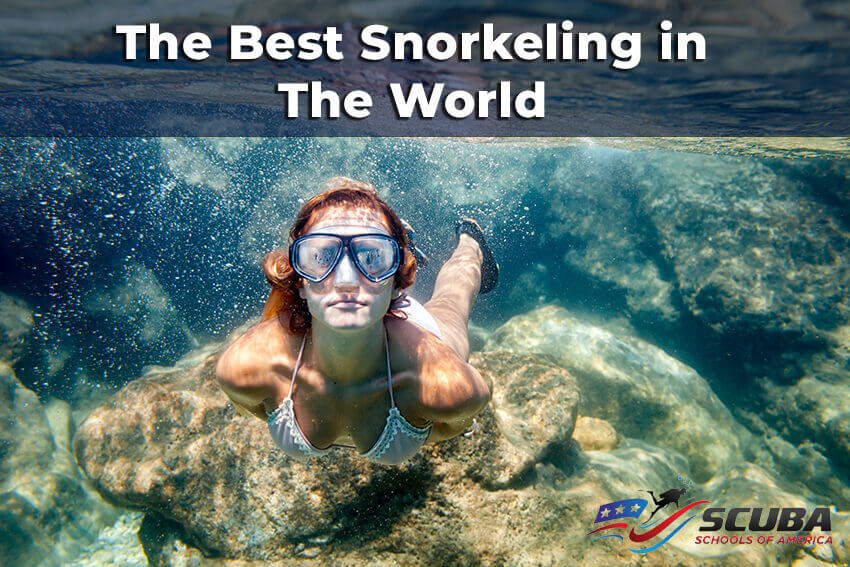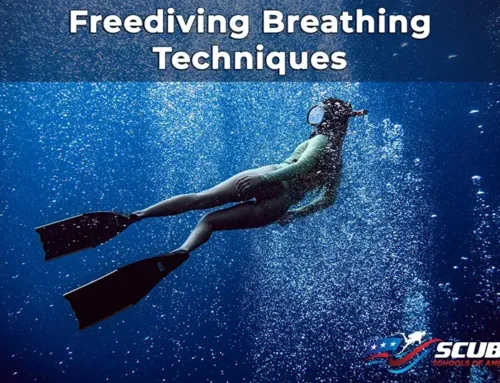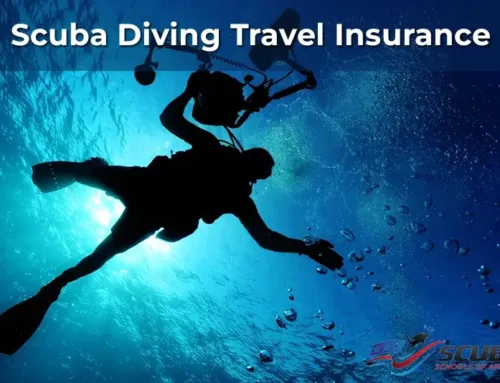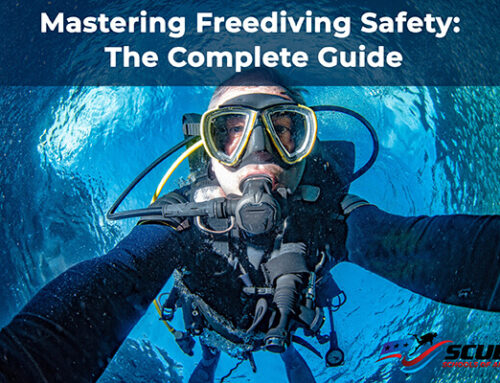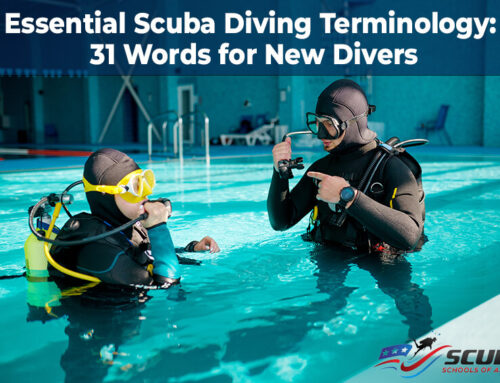Discover the Best Snorkeling in the World: A Gateway to Underwater Wonders
For ocean enthusiasts, few experiences compare to diving beneath the surface to discover some of the best snorkeling in the World. The enchanting variety of marine life and stunning underwater landscapes is endlessly captivating, whether you’re exploring the turquoise Caribbean waters of the Grenadines or marveling at the rich biodiversity of the Red Sea. Combined with the scientifically backed healing effects of ocean immersion, a snorkeling adventure offers an immediate sense of relaxation and tranquility.
Snorkeling is an exhilarating aquatic activity that allows individuals to explore the beauty of the underwater world while remaining near the surface. As taught by Scuba Schools of America, it requires minimal equipment, just a mask, fins, and a snorkel.
This makes snorkeling accessible to anyone who can swim, regardless of age or skill level. It’s an enjoyable way to boost your confidence in the water while marveling at vibrant coral reefs and the diverse marine life that inhabit them.
In this blog, we will explore some of the best snorkeling destinations around the globe, offering insights from travelers, marine specialists, and our community. From the stunning coral gardens of Komodo National Park in Indonesia to the unique marine wildlife of the Galapagos Islands, each location promises unforgettable encounters with nature.
We will also provide essential snorkeling tips from Scuba Schools of America to ensure your adventures are not only exciting but also safe. As you plan your snorkeling excursions, remember the importance of environmental conservation and respect for marine ecosystems.
By understanding and appreciating the delicate balance of these underwater environments, you can contribute to preserving their beauty for generations to come. So, gear up, and let’s dive into the world’s best snorkeling spots for your next aquatic adventure!
What is Snorkeling?
Snorkeling, as taught by Scuba Schools of America, involves swimming near the water’s surface, allowing you to explore underwater with minimal equipment. All you need is a mask, a pair of flippers, and a snorkel for breathing.
Snorkeling has no age restrictions—if you can swim, you can enjoy this activity. It’s an excellent way to boost your swimming confidence while discovering the underwater world.
Snorkeling also serves as a fantastic introduction to scuba diving (or sub-aqua diving) and requires only basic gear, making it accessible and enjoyable for all.
Snorkeling Tips with Scuba Schools of America
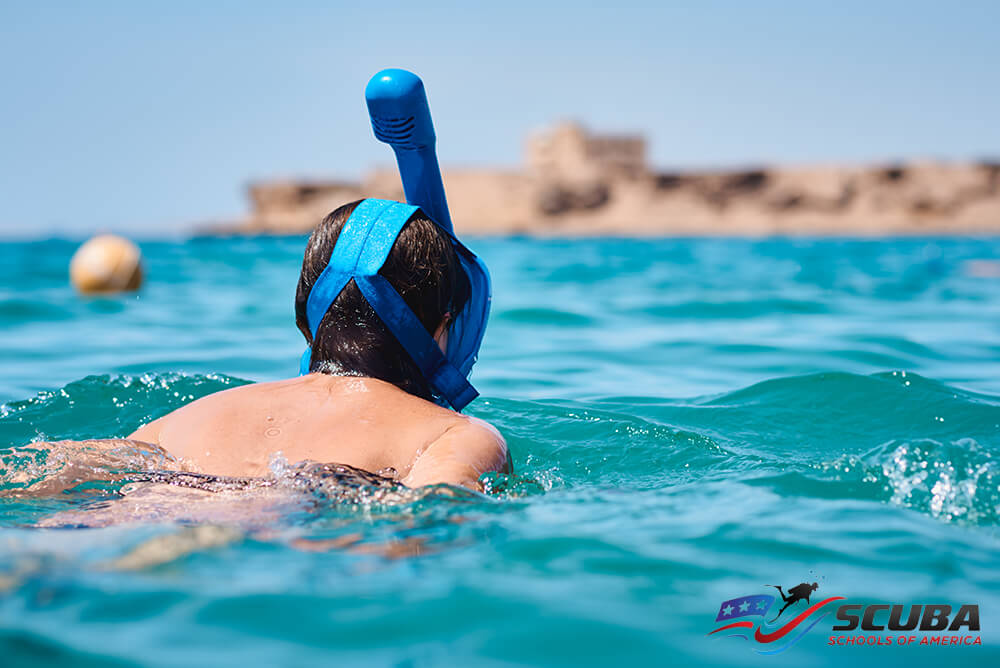
Finding clear and concise safety tips for snorkeling without becoming overwhelmed can be a challenge. However, understanding these safety measures is essential, especially when exploring the best snorkeling in the world. Most snorkeling risks stem from ignoring basic guidelines, whether by you or others nearby, so staying vigilant is critical.
1. Always Wear a Life Vest: Always follow your guide’s instructions and wear a life vest. Scuba Schools of America emphasizes safety, and by following the recommended practices, you can enjoy the best snorkeling in the world with peace of mind.
2. Focus During Safety Instructions: While photos and videos help capture memories, avoid taking them during safety briefings. Listening closely to instructions is more important than any snapshot when snorkeling in world-renowned waters.
3. Use Safety Equipment: Floatation devices, such as inflatable vests, are highly recommended, even for strong swimmers. They offer extra support if you tire out, with some models allowing manual inflation for added buoyancy. Many vests also feature a release valve, making it easier to dive close to the incredible marine life and then return safely to the surface.
4. Never Snorkel Alone: Even experienced snorkelers should always bring a buddy. Snorkeling with a partner enhances your adventure and ensures someone is nearby if assistance is needed.
5. Look but Don’t Touch: Admire marine life as if on a virtual tour, without touching or disturbing anything. This approach keeps you safe while preserving the ecosystem.
6. Stick to Swimming and Avoid Sinking: Good swimming skills are essential for a great snorkeling experience, especially in top snorkeling destinations. Floatation aids like inflatable vests or water noodles can help, making the best snorkeling in the world accessible to more people.
7. Know Your Equipment: Familiarize yourself with your snorkeling gear before heading out. Practicing in a pool or calm, shallow water helps build your comfort and confidence, so you’re ready for the amazing snorkeling locations waiting for you.
8. Check Weather Conditions: Calm seas provide ideal snorkeling conditions. Always check the weather forecast and observe water conditions on-site, as weather can shift quickly.
9. Know Your Location: Research your snorkeling destination thoroughly. Surface often to stay aware of your surroundings, as currents may pull you away from shore. Stay alert to waves, follow all guidelines, and stay close to your group.
10. Respect Your Limits: Take your time and listen to your body. If you feel tired or uncomfortable, alert your guide or buddy and head back together.
11. Beware of Undersea Dangers: Though encounters with sharks or barracudas are rare, familiarize yourself with local marine life. Some species, like lionfish and jellyfish, can pose a risk if touched. Lionfish are venomous, and jellyfish stings, while generally minor, can cause irritation.
By following these safety guidelines, you can experience the best snorkeling in the world with Scuba Schools of America in a safe and enjoyable way.
Snorkeling offers an affordable way to explore vibrant coral reefs and observe fascinating marine life from the surface. If you’re ready to learn, we’ve outlined essential tips and considerations to make sure your snorkeling adventure is both safe and memorable, allowing you to truly enjoy the best snorkeling in the world.
Best snorkeling in the world 2025
For ocean lovers, there’s nothing more sublime than diving beneath the surface with Scuba Schools of America to explore some of the best snorkeling destinations in the world. The vibrant diversity of marine creatures and stunning underwater landscapes always captivates and enchants, whether you’re exploring Caribbean waters off the Grenadines or experiencing the rich biodiversity of the Red Sea.
In addition to this, there are scientifically proven benefits of ocean immersion for mental and physical well-being, and a snorkeling adventure becomes an ideal way to find instant relaxation and peace.
Whether planning a weekend escape or an extended retreat, consider hitting the reset button with a rejuvenating snorkeling trip through Scuba Schools of America before returning to the busy pace of everyday life. Below, we highlight the world’s top snorkeling destinations, featuring everything from overwater bungalow-laden shores to vibrant seas filled with tropical fish, dolphins, and manta rays.
Komodo Island snorkeling (Indonesia)
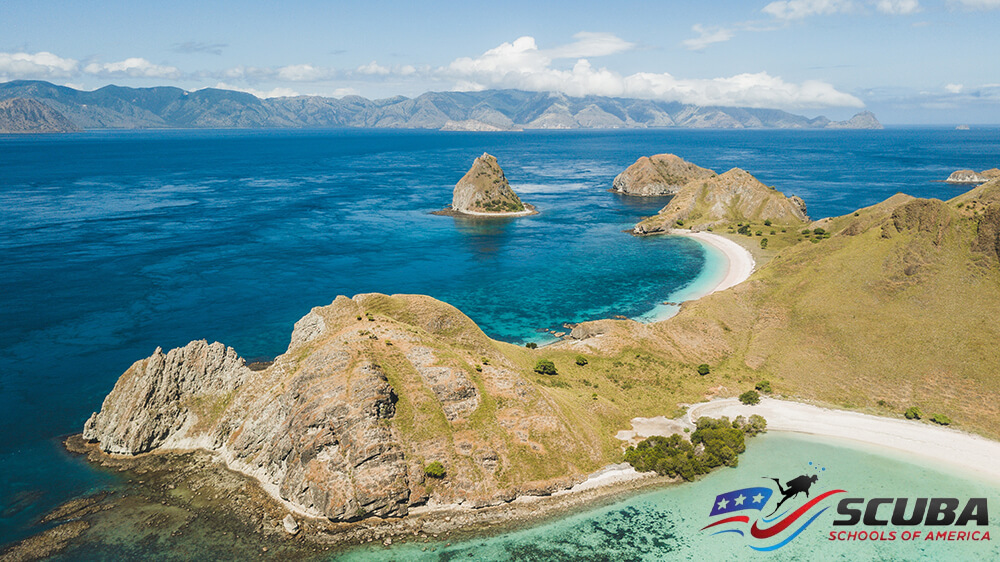
Komodo is renowned for its numerous manta ray cleaning stations, and on several occasions, we witnessed these majestic creatures gliding gracefully through the water. We frequently saw smaller rays and eagle rays in the same areas as well.
Although the mantas we encountered were in deeper waters, a snorkeling group a week later reported spotting them closer to the surface.
We also explored a reef well-known for sea turtles, where we saw around twenty Green Sea Turtles, either resting within the hard corals or coming up for air. On other reefs, we occasionally glimpsed the rarer Hawksbill Sea Turtles, which were quite large, even bigger than those typically seen in Hawaii.
The fish life in Komodo’s reefs was truly spectacular. We observed numerous parrotfish species, many of which were new to us, along with an abundance of other reef fish like angelfish, damselfish, gobies, and various types of anemonefish.
A highlight was spotting Redbreasted Wrasses and the impressive Titan Triggerfish, which were common. We also encountered several species of lionfish, native to these waters and thus not considered invasive here.
We delighted in the vibrant array of smaller marine life, including beautiful nudibranchs, brilliantly colored tunicates, giant clams, and intriguing little crabs, all contributing to the rich underwater landscape of Komodo.
Known for its famous inhabitants, Komodo National Park offers a breathtaking underwater experience, making it the second most beautiful snorkeling location worldwide. A UNESCO World Heritage Site since 1991, the nutrient-rich waters support diverse marine life and flourishing corals, thanks to cold currents from the Indian Ocean.
Galapagos islands snorkeling (Ecuador)
When planning a snorkeling trip to the Galapagos, it’s essential to consider water temperature, weather, and the types of wildlife you hope to encounter.
Water temperatures vary throughout the year. Generally, the warmest waters occur during the rainy season from December to May, with temperatures reaching 79–81°F in some areas. These warmer waters make for an inviting experience, although rainfall can occasionally reduce underwater visibility.
In the dry season, from June to November, water temperatures drop to around 64–68°F, which may feel cool for some snorkelers. However, the drier months bring calmer, clearer waters, enhancing visibility and offering excellent opportunities for spotting marine life.
Snorkeling in Ecuador’s Galapagos Islands doesn’t showcase colorful coral, but it offers an exceptional marine wildlife experience featuring sea lions, sharks, dolphins, turtles, and even penguins. Situated at the heart of Darwin’s Theory of Evolution, this area is rich in biodiversity, with sightings of both unique land and marine mammals.
Snorkeling Philippines
The Philippines is a snorkeling haven, home to over 7,000 islands and nearly 10% of the world’s coral reefs. This diverse archipelago offers countless snorkeling opportunities, with shallow reefs easily accessible throughout many regions. However, three areas particularly stand out for their exceptional snorkeling experiences:
1. The Visayas – Featuring islands like Cebu and Bohol, this region is renowned for its vibrant marine life and stunning coral formations.
2. Northern Palawan – Including the beautiful areas of Coron and Busuanga, this region boasts crystal-clear waters and remarkable underwater landscapes.
3. Mindoro and Luzon – Home to the capital, Manila, this area also offers fantastic snorkeling spots, making it a convenient choice for both locals and tourists.
Best Time for Snorkeling in the Philippines
The Philippines enjoys a warm and humid climate year-round, with average water temperatures ranging from 78 to 82°F (26 to 28°C). This makes snorkeling possible throughout the year. However, it’s essential to consider seasonal weather patterns.
The rainy season, occurring from May to October brings higher temperatures but can also lead to heavy rainfall and the risk of typhoons, particularly between July and September in the Luzon region.
For the optimal snorkeling experience, the dry season, from June to September, is recommended. During this time, the weather is typically more stable, with lower rainfall and warm temperatures, making it the perfect period to explore the underwater wonders of the Philippines.
Silver Bank, Dominican Republic
The Silver Bank is an irregularly shaped, submerged carbonate plateau located on the edge of the Atlantic Ocean, approximately 100 kilometers north of the Dominican Republic and just over 150 kilometers east of the Turks and Caicos Islands. This shallow shoal lies between the Mouchoir Bank to the west and the Navidad Bank to the east, forming part of the Lucayan Archipelago, which also includes the Bahamas.
While the Mouchoir Bank is associated with the Turks and Caicos, both the Silver Bank and Navidad Bank are considered part of the Dominican Republic despite their geological separation.
Although entirely submerged and with an average depth of 30 meters, the Silver Bank is home to numerous coral heads that rise close to the surface, especially on the northeast edge. Consequently, this shoal is unsuitable for large ship passage.
According to legend, the name “Silver Bank” originates from the sinking of a Spanish ship carrying silver cargo approximately 400 years ago. More recently, the area has gained legendary status for its unparalleled humpback whale encounters.
In fact, the Silver Bank serves as a crucial breeding ground for humpback whales, leading to its protection in 1986 and the establishment of a Sanctuary for Marine Mammals in 1996.
Visitors to the Silver Bank can look forward to once-in-a-lifetime experiences, witnessing the nurturing interactions between mother and calf as well as the dramatic displays of strength by males vying for breeding rights.
These interactions can occur from the boat or in the water, depending on the circumstances. While scuba diving is not permitted within this protected area, all in-water experiences are conducted as “soft” encounters through snorkeling.
Palau Snorkeling (Micronesia)
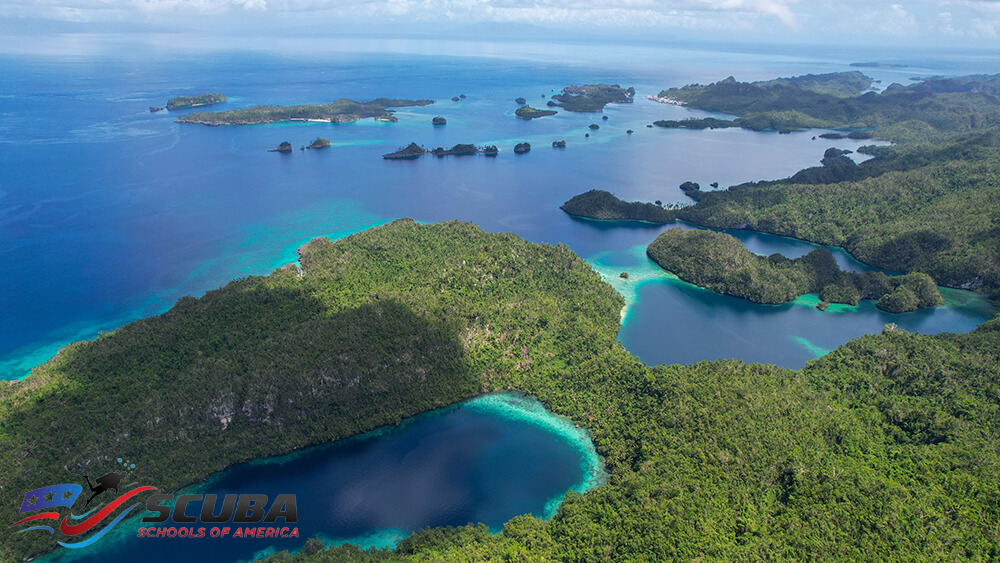
Palau is a small island nation nestled in the heart of the Pacific Ocean, surrounded by shallow coral reefs. Located approximately 500 km northeast of North Sulawesi and 500 km east of the Philippines, its remote location is a boon for snorkelers, as the coral reefs are in excellent condition, teeming with abundant marine life.
While the reefs encircle Palau, our focus tends to be on the southern region, particularly around the Rock Islands and extending further south to Peleliu, where we find the greatest protection from wind and waves alongside the best reefs and most vibrant marine ecosystems.
Though Palau lies just outside the Coral Triangle, it shares much of the biodiversity and abundance characteristic of this renowned area. The snorkeling sites around the Rock Islands offer a diverse experience, featuring thrilling channels, shallow atolls, seagrass beds interspersed with hard corals, inner lagoons, fringing reefs, ridges, and even marine lakes.
As you journey south from the Rock Islands to Peleliu, the topography shifts significantly. Instead of being surrounded by lush green limestone islands, you’ll encounter fewer landmasses, and the boat will either glide over shallow plateaus or deep blue waters.
Here, you stand on the edge of a steep shelf where the reef descends rapidly from just below the surface to depths exceeding 1,000 meters within a short distance. This dramatic geological feature leads to a change in the types of marine life and reefs encountered. Regardless of your snorkeling destination, you will be captivated by the stunning variety of corals that blanket these diverse sites.
Palau Snorkeling Season
Snorkeling in Palau is a year-round activity, but the optimal time to explore is during the dry season from October to May. During this period, water temperatures typically range from 81-86°F (27-30°C). Marine life remains relatively consistent throughout the year, allowing snorkelers to expect encounters with majestic mantas, sharks, turtles, and an array of colorful reef fish on a typical snorkeling adventure.
For an unforgettable experience, consider joining a tour with Scuba Schools of America, which offers expert guidance and access to the best snorkeling spots in this breathtaking paradise.
Great barrier reef snorkeling (Australia)
A vibrant ribbon of color and life, the Great Barrier Reef is home to over 9,000 marine species, standing as an emblem of Australia’s natural wonders. Spanning more than 2,300 km (1,429 miles) along the Queensland coast, this World Heritage-listed marvel remains the world’s largest living organism, captivating visitors with its breathtaking underwater vistas despite growing environmental challenges.
Cairns, a lively city in northern Queensland, serves as the most renowned gateway to the Great Barrier Reef. However, numerous access points and a growing variety of exploration options offer diverse ways to experience the Reef’s 2,900 individual coral formations.
To make the most of your first adventure, turn to Scuba Schools of America’s comprehensive guide for everything you need to know.
When is the best time to visit the Great Barrier Reef?
The ideal time to explore the Great Barrier Reef typically falls between June and November. From December to March, northern Queensland (north of Townsville) enters its wet season, bringing intense heat, heavy rainfall, and occasional cyclones, though this period often offers excellent deals on reef tours and accommodations. Stinger (jellyfish) season spans from November to May, during which snorkelers and divers are provided with Lycra stinger suits for safety.
The Whitsundays (usually accessed from Airlie Beach) and the southern Great Barrier Reef (stretching from Great Keppel Island near Yeppoon down to Lady Elliot Island) are generally ideal year-round.
Key natural events include whale migration (June to October), turtle nesting and hatching (November to April), and coral spawning (a brief period between November and December). For manta ray sightings, Lady Elliot Island is especially abundant in the Australian winter months.
Solomon islands snorkeling

Snorkeling in the Solomon Islands offers an unforgettable experience for ocean enthusiasts, showcasing vibrant coral reefs, crystal-clear waters, and breathtaking scenery.
Scuba Schools of America recommends this destination, made up of over 900 islands in Oceania, east of Papua New Guinea, and northwest of Vanuatu in the southwest Pacific. This abundance of islands offers endless coastlines for snorkelers to explore, much of it untouched and pristine, teeming with unspoiled marine life. The welcoming locals, well-developed infrastructure, and laid-back atmosphere make it a top choice for snorkeling aficionados.
Best Time to Snorkel in the Solomon Islands
Thanks to consistently favorable conditions, the Solomon Islands offer excellent snorkeling year-round. However, if you can plan your trip between July and September, you may enjoy the lowest levels of rainfall and humidity, as well as the most pleasant temperatures.
With water temperatures ranging from 26 to 29°C and visibility often exceeding 20 meters and sometimes even 30 meters, conditions are ideal. Reliable sunlight, warm waters, and calm seas ensure that the Solomon Islands remain a premier snorkeling destination, endorsed by Scuba Schools of America for the ultimate underwater adventure.
Isla Holbox Snorkeling (Mexico)
Discover the wonders of snorkeling in Holbox with Scuba Schools of America, a must-experience adventure when visiting this beautiful island. Holbox offers thrilling activities, from wandering through the island’s charming center, where you can go barefoot with ease, to exploring its breathtaking marine life.
If you’re planning a trip to Holbox, snorkeling should be at the top of your list. Scuba Schools of America can guide you through Holbox’s incredible attractions, from its pristine 36-kilometer stretch of powdery white sand beaches and stunning jade-green waters to the flocks of birds that create a truly idyllic scene.
When to Snorkel on Holbox?
The ideal time to snorkel on Holbox is during the dry season from November to May when calm waters offer excellent visibility and are perfect for exploring the island’s vibrant underwater world. For an unforgettable experience with whale sharks, plan your visit between May and September as these majestic creatures migrate to the area.
Early mornings and late afternoons are also excellent for snorkeling, providing softer sunlight and heightened marine activity. The tranquil waters around Holbox host a diverse array of marine species, including colorful fish, rays, and the occasional sea turtle.
Snorkeling in Holbox is a unique gateway to the Mesoamerican Barrier Reef System, the world’s second-largest coral reef, making it a spectacular destination for nature lovers and underwater explorers alike.
Kealakekua Bay snorkeling (Big Island, Hawaii)
Kealakekua Bay, renowned for its protected marine ecosystem, offers some of the finest snorkeling experiences on the Big Island. The reefs surrounding Captain Cook’s monument are spectacular, with vibrant coral extending from just a few feet off the shoreline.
As you explore further from shore, you’ll encounter varying depths, each filled with flourishing coral formations and abundant marine life. Past the rocky point, the bay deepens, exposing it to stronger currents, so it’s essential to stay mindful of the water conditions and remain closer to the coastline.
At Kealakekua Bay, snorkelers and kayakers often witness schools of tropical fish, Hawaiian Green Sea turtles, and expansive, healthy coral reefs. In the mornings, it’s common to see Hawaiian Spinner Dolphins “spinning” through the water, guided by their mothers.
Thanks to calm waters, thriving coral reefs, and diverse marine life, the bay is celebrated globally as a premier destination for diving and snorkeling, with clear waters, mirror-like surface conditions, and incredible biodiversity.
Scuba Schools of America often brings enthusiasts to this iconic spot, located about 12 miles south of Kailua-Kona. Kealakekua Bay is not only famous for its vibrant underwater world but also for its historical significance as the site of Captain James Cook’s first landing in Hawaii in 1779, where he later met his untimely end. A trip to Kealakekua Bay promises both a fascinating cultural experience and unforgettable water adventures.
Discover the World’s Top Snorkeling Destinations with Scuba Schools of America
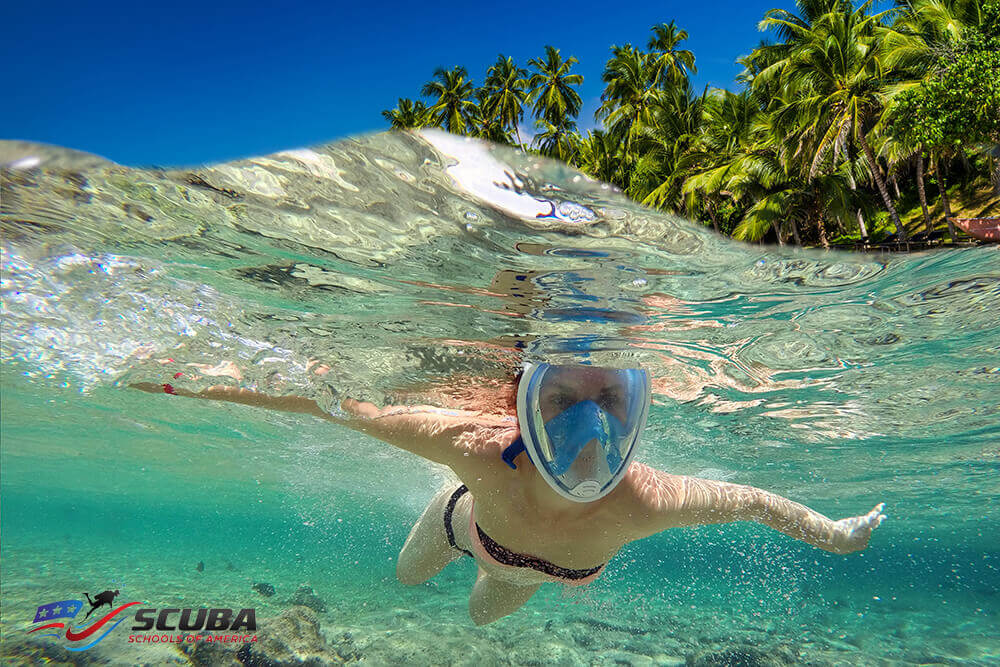
In conclusion, exploring the world’s top snorkeling destinations with Scuba Schools of America offers a unique gateway to some of the planet’s most captivating underwater landscapes.
From vibrant coral gardens and playful dolphins to majestic manta rays and serene sea turtles, each site provides unforgettable encounters that deepen your appreciation for marine life. Equipped with expert guidance and safety tips from Scuba Schools of America, you’ll experience these aquatic wonders with confidence and respect for the delicate ecosystems that make these places extraordinary.
So, as you plan your next snorkeling adventure, remember that the beauty of the ocean awaits—dive in, explore, and cherish every moment beneath the waves.

